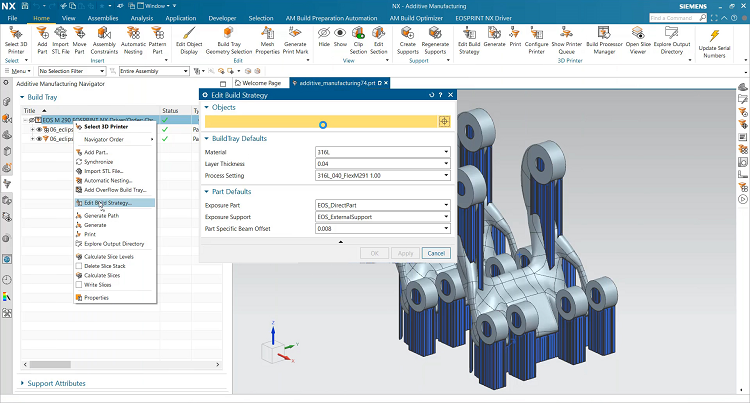Siemens in Talks to Acquire Altair Engineering: Implications for 3D Printing and Advanced Manufacturing
Siemens AG is reportedly in discussions to acquire Altair Engineering Inc., in what could be a landmark acquisition for the German engineering giant. Sources indicate that Siemens is working with advisors to navigate the potential purchase, although there’s no guarantee that these talks will lead to a definitive agreement. With Altair’s market value pegged at approximately $9.1 billion, this would surpass Siemens’ largest acquisition to date, that of oil and gas equipment manufacturer Dresser-Rand Group Inc. in 2015. This strategic move underscores Siemens’ continued growth from heavy machinery to software-centric growth areas, aimed at boosting profitability in sectors like factory automation.
Altair, a prominent player in the engineering software landscape, has seen its stock price rise by 27% this year, largely driven by news of its potential sale. Under the leadership of CEO James Scapa, Altair’s suite of software solutions caters to industries including aerospace, automotive, energy, and financial services. As Siemens deepens its software focus under CEO Roland Busch, the acquisition aligns with the company’s broader vision of leveraging digital tools to stay competitive with other automation heavyweights like Rockwell Automation and Schneider Electric.

The integration of NX AM software with EOS’ job and process management software EOSPRINT 2
enables users to generate EOS build files directly in NX, defining material, exposure sets, and beam offset values, among other variables.
In the context of 3D printing, Siemens and Altair have each played influential roles. Siemens’ Digital Industries Software (DI Software) provides key platforms like NX and Simcenter, which are commonly used for simulating and optimizing 3D printed parts, enabling manufacturers to streamline production and cut down on costly iterations. Siemens’ focus has been on integrated solutions that unify the design and manufacturing processes, a critical step for making additive manufacturing (AM) a more viable alternative to traditional methods. Altair, on the other hand, is known for its strength in topological optimization and simulation, with Altair Inspire and HyperWorks offering tools to maximize material efficiency and performance in 3D-printed components. These platforms are vital in sectors like automotive and aerospace, where lightweight and high-strength parts are key.

A mold optimized using Altair software and 3D printed by PROTIQ. Image courtesy of Altair.
If Siemens succeeds in acquiring Altair, the combined expertise could revolutionize how manufacturers approach AM, bringing together Siemens’ strengths in integrated design-to-production workflows and Altair’s capabilities in advanced simulation and optimization.
Broader Industry Context: Autodesk, NAVASTO, and the AI Push
The Siemens-Altair discussions come amid a series of strategic moves by other major players in the design and manufacturing software space. Earlier this month, Autodesk announced the acquisition of NAVASTO, a company focused on using AI to accelerate design and engineering. Autodesk’s strategy with NAVASTO revolves around integrating AI-based wind tunnel simulations directly into its Alias platform, enabling automotive designers to optimize aerodynamic performance earlier in the design process. This acquisition highlights Autodesk’s broader AI-driven approach, which is also evident in its industry-specific foundation models that automate repetitive tasks and enhance creative workflows.

Wind tunnel simulation in NAVASTO. Image courtesy of NAVASTO/Autodesk.
The NAVASTO deal aligns with Autodesk’s emphasis on AI and advanced automation, similar to Siemens’ focus with Altair. By embedding NAVASTO’s capabilities, Autodesk is setting the stage for more intuitive and productive design iterations, emphasizing that AI-powered simulation is crucial to maintaining competitiveness in sectors where design complexity is rising. This approach not only strengthens Autodesk’s design software portfolio but also solidifies its position as a leader in AI-driven manufacturing solutions.
Contextualizing the Siemens-Altair Deal: The Software Consolidation Trend
The potential Siemens-Altair deal arrives at a time when major moves are being made in the broader design and simulation software industry. Earlier in 2024, Synopsys announced plans to acquire Ansys for $35 billion in a move that would consolidate two of the largest players in electronic design automation (EDA) and simulation software. This mega-merger is driven by the semiconductor industry’s shift towards chiplets, which require more sophisticated simulation and packaging techniques—areas where 3D printing is increasingly being explored as a solution.
The Synopsys-Ansys deal underlines the critical importance of software in advanced manufacturing. For companies like Siemens, which have historically been rooted in heavy equipment and hardware, the shift towards acquiring robust software portfolios is a natural response to the increasing digitization of manufacturing. In an industry where simulation and data-driven decision-making play essential roles, the acquisition of Altair could mirror the Synopsys-Ansys strategy of broadening software capabilities to unlock growth and new applications, such as 3D printing for advanced packaging.

Additive manufacturing simulation with Ansys. Image courtesy of Ansys.
Ultimately, Siemens’ interest in Altair reflects a broader trend of consolidation aimed at redefining the advanced manufacturing sector. With software increasingly being the linchpin in the adoption of AM technologies (see AI-driven software firms like 1000 Kelvin, as an example), these acquisitions highlight a growing recognition of the importance of digital tools in shaping the future of manufacturing. If successful, this deal could solidify Siemens’ position not only in the automation space but also in AM, where integrated software solutions are key to unlocking full-scale production capabilities.
As the industry watches these developments unfold, it becomes clear that software is not just a side player in 3D printing—it’s the main driver for growth and integration into traditional manufacturing processes.
Subscribe to Our Email Newsletter
Stay up-to-date on all the latest news from the 3D printing industry and receive information and offers from third party vendors.
Print Services
You May Also Like
New Business: Temporary, Migratory, & Modular 3D Printed Architecture
If we look at potentially emerging 3D printing businesses, then architecture has not been fully explored. Yes, there is a lot of house 3D printing going on worldwide. From deployable...
3D Printing News Briefs, April 19, 2025: Material Extrusion Standard, Metal Powder, & More
In today’s 3D Printing News Briefs, we’re covering a proposed standard for material extrusion, before moving on to business and metal powder. We’ll end with a commercial store’s robotic 3D...
Japan Unveils World’s First 3D Printed Train Station
Japan is now home to what we believe is the world’s first train station built with 3D printing technology. Located in Arida City, just south of Osaka, the new Hatsushima...
restor3d Raises $38M to Expand 3D Printed Orthopedic Implants
Backed by $38 million in new funding, restor3d is pushing ahead with the launch of four personalized implant lines, set to roll out in 2025 and 2026. This latest venture...

























